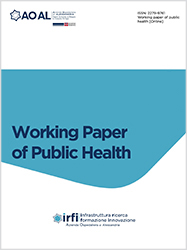Prognostic value of PRO-ADM biomarker in patients with COVID-19

All claims expressed in this article are solely those of the authors and do not necessarily represent those of their affiliated organizations, or those of the publisher, the editors and the reviewers. Any product that may be evaluated in this article or claim that may be made by its manufacturer is not guaranteed or endorsed by the publisher.
This study was performed at the analytical laboratory of the Hospital SS. Antonio e Biagio e Cesare Arrigo" Hospital in Alessandria (AL) in the period March-June 2020. This is an observational, prospective, single-center study carried out on a cohort of patients diagnosed with ARDS secondary to SARS-CoV2 infection admitted in the first wave of the pandemic at the Sub-Intensive Care Unit of the Hospital of Alessandria. OBJECTIVE The aim of this study was to assess plasma concentrations of the regional mean proadrenomedullin biomarker (MR-proADM) at the time of patient access to the Emergency Department and subsequently 1, 3 and 5 days after admission, to verify its prognostic value in terms of short-term mortality. The second objective of the study was to compare this biomarker with other commonly used biomarkers such as PCR and Procalcitonin, to evaluate the effectiveness of MR-proADM in risk stratification in these patients. METHODOLOGY Samples used in this study were collected in a tube containing the anticoagulant EDTA, and measurements were performed using a fully automated instrument: the Kryptor Compact Plus. RESULTS Among the various Biomarkers assayed only MR-proADM and LDH concentrations were significantly higher in deceased patients than in surviving patients while no statistically significant difference was observed for PCR PCT concentrations. Increasing levels of MRproADM between the second and fifth day of admission to the intensive care unit represent the key to determining mortality risk. CONCLUSIONS Mr-proADM was found to be a more effective biomarker than other commonly used biomarkers (PCR, WBC, Procalcitonin) in identifying Covid-19 patients with poor prognosis at an early stage. This study allowed clinicians to routinely include the assay of this biomarker, useful in the stratification of these patients and in predicting a higher or lower risk of mortality, in the second wave of the epidemic.
Supporting Agencies
Covid-19, MR-proADM, Kryptor Compact PlusPAGEPress has chosen to apply the Creative Commons Attribution NonCommercial 4.0 International License (CC BY-NC 4.0) to all manuscripts to be published.

 https://doi.org/10.4081/wpph.2021.9312
https://doi.org/10.4081/wpph.2021.9312




